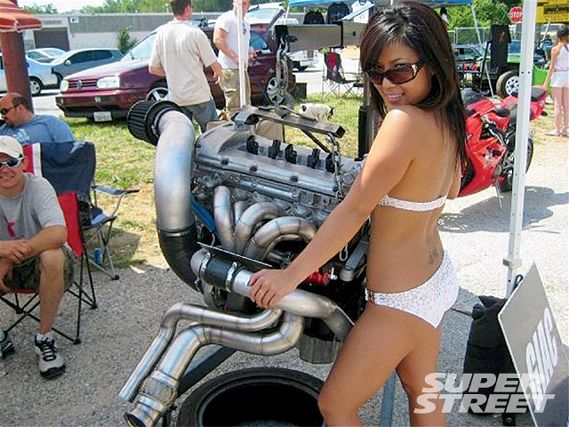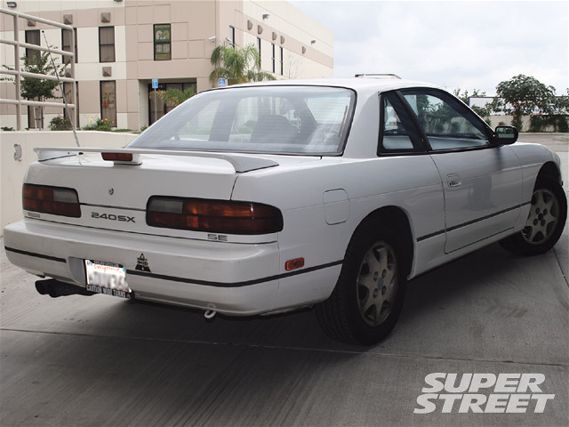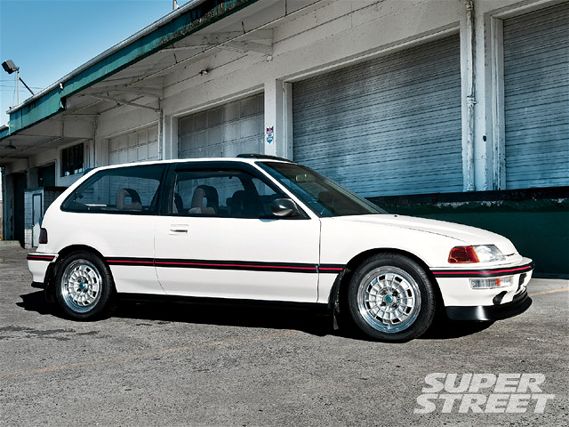 | Tech Support March 2009 - Rear End
| Tech Support March 2009 - Rear End
Here's where we act like we know something technical about cars. Feel free to ask us about your technical troubles. Write us at tech@superstreetonline.com or Super Street c/o Tech Support, 6420 Wilshire Blvd., Los Angeles, CA 90048. Feel free to include a picture of your project or tech problem.
Question Of The Month
Q I own a 98 DC2 LS. That is not the problem. The problem is the automatic transmission. In first gear and second, occasionally it slips. Sometimes it shifts hard. I have flushed it out and put all new clean fluid back in, but got the same results. Is there something I didn't do right or do you think it's time for a new transmission? The previous owner put about 165k on the car, but it was clean when I bought it. Now sitting at about 185k, has this transmission just seen better days? Tell me something. Keep up the great work (for your minimal pay). I'll continue subscribing.
K.J.
Via the Internet
 | Tech Support March 2009 - Rear End
| Tech Support March 2009 - Rear End
A Diagnosing a problem on an automatic transmission is difficult enough when you have the car in front of you and nearly impossible when you can't see or drive it. There are a few signs you should be looking for that could indicate an internal problem with the clutch packs. First, look at the condition of the fluid. If it's dark in color and smells burnt, chances are that it's time to rebuild/replace. The other thing is to check the bucket that you drained your fluid into to see if there are any metallic flakes or bits of clutch material deposited at the bottom. These are tell-tale signs of an internal problem. If the fluid looks good and the bottom of your bucket is clean, the next step is to check for transmission-related codes stored in the computer. It's possible to have a failure with the solenoid that controls the line pressure in the system, which can lead to a slip. On the other hand, if the codes hint toward a mechanical problem, the unit will likely need to be torn apart for an inspection.
Q Hey guys, you have the best magazine on the import scene and best advice so this is why I wrote you. I have a Nissan 240SX with a little over 200k miles on it. It started to overheat out of nowhere and I checked the usual. I changed thermostat, fan clutch (mechanical fan), flushed my system and checked my water pump but my car would still overheat. Now the kicker is that when it overheated a lot of white smoke came out of my exhaust, so I put in block seal just in case it was the head gasket. After that was done my car still overheated and still emitted white smoke. SoI thought to myself, maybe my thermostat is still bad. I changed it, then I took it out and now my car doesn't overheat. My question is, is it safe to run my car without a thermostat?
Michael Gomez
Via the Internet
 | Tech Support March 2009 - Rear End
| Tech Support March 2009 - Rear End
A Michael, we hate to say this but not having a thermostat sounds like the least of your problems. As you've probably already heard, white smoke puffing out the exhaust is a pretty good indicator of a blown head gasket. The sealer you put in may help in the short run, but if you've truly got a blown the head gasket, you'll either need to repair it or replace the engine shortly. We'd recommend that you remove the spark plugs and pressurize the cooling system. In most cases, when the head gasket is blown, this procedure will cause coolant to seep into the cylinder where the gasket is damaged, giving you information about the nature of the problem-if you have one at all. Examining the spark plugs could also give you a general idea if water is leaking into the combustion chamber. To answer your question, it's pretty safe to run a car without a thermostat. The main drawback is that the engine will take much longer to get up to operating temperature. If you live in a very cold area, the engine may never get to operating temperature. This can cause poor performance and bad gas mileage. From a theoretical standpoint, if your headgasket is not blown, your car should be able to run properly with a thermostat installed. If removing it solved your problem, it may have been that the thermostat wasn't opening properly due to trapped air in the system or an improperly installed thermostat. When installing the thermostat, be sure to put it in right side up. There's a small hole with a pin through it that must be located at the top. This will allow air to pass through it to avoid an air pocket around the thermostat. Also, once you get everything back together, be sure to bleed out any air through the bleed valve located by the upper radiator hose.
Q I have a question about the S14 SR20DET wiring harness conversion. What exactly do I have to do, what plugs do I have to cut, and which do I have extend? The reason for my question is because I am doing the S14 SR20DET to S14. That is the only thing I need to do to finish. Please let me know where I can get a harness diagram or can you tell me what wires go with what. Thank you very much.
Robert Mireles
Fontana, CA
A The wiring conversion for the S14 engine into the S14 chassis is not as difficult as many think. For starters you'll need to extend the wires for the MAF sensor. To do this we recommend using a shielded wire. Most of the actual work is done on the M63/F4 connector located on the passenger's side kick panel above the ECU. This is the white connector with a black cover on the back. Unfortunately, we don't have a link to a specific website that will show you the correct order for the wires. There is a lot of information on the web, both good and bad. The correct way to do this is to use the wiring diagrams from both the KA and SR factory service manuals to make sure the conversion information that you can find on various forums is correct. The S14 SR20DET ECU is not easy to find or cheap to replace, so you don't want to risk hooking things up improperly.
Q I just got done reading the December '08 issue. I am the owner of a 1996 Civic DX. It's time to get new brakes. I am having a hard time finding kits to convert the rear drums to disk. I thought that I would take the time to install a better quality brake system. I have changed the front disks a couple of times in its life because I always seem to warp the rotors. Any suggestions would be great. I would like to fix this car up some day to hopefully be in your magazine. I appreciate your time and effort.
Rob
Monterey Park, CA
A One of the great things about having a Honda is that most parts interchange like Legos. In your case, you can source the parts for your rear disc brake conversion from almost any Integra or Civic that came with rear discs. Off the top of our heads, this includes any '90 to '01 Integra or '90 to'00 Civic/CRX. The basic parts you'll need are the complete rear trailing arms and E-brake cables. While you can get away with just the spindles, brakes, brackets, hydraulic lines, E-brake cables and miscellaneous hardware, we find it simplest to go ahead and replace the entire assembly, including the trailing arms. Some other recommended parts to source from the donor vehicle are the master cylinder and proportioning valve. For those who really don't want to be bothered chasing down used parts, fastbrakes.com can supply you with a complete kit for the upgrade. We also recommend that you check out issue number seven of Project Car Magazine for a step-by-step installation guide. Although the install was done on JDM Wong's EF, the basics are all the same.
Q What's up Super Street? I am a 17- year-old with a part-time job and just got my license and I'm really into circuit racing and touge. I wanted to know what will be a good car to start out with for that type of racing within a $3,000 dollar budget. (I've been a fan since my big brother first started buying the mag in 2002).
Jaime Cordero
New London, CT
A Getting into circuit racing can be a lot of fun but can get expensive. The cheapest way to get started is to find a local autocross event to join. This will allow you to run your car on an actual race track without a lot of special equipment or a racing license. To answer your question, we would recommend starting out with a lightweight car as it'll help keep the budget under control. Consider the basic costs of racing a car when making your selection. You'll go through a lot of gas, tires and brakes learning the basics, so chose something that will be low maintenance and cheap to run. Focus on handling and reliability when getting started. Save the high power, large tires and big brakes for when you can afford them, along with a truck and trailer. The Honda Civic (EF and EG), and Mazda Miata would be a few of our top picks, due to the vast amount of aftermarket parts available for them. Other great choices in your price range would be the Acura Integra (DA), Toyota MR-2, Nissan 240SX, and Sentra SE-R. There are a lot of other great cars, but those are the ones that immediately come to mind. Be sure to check out Project Car Magazine, as they feature step-by-step DIY builds on a lot of cars in your price range. In fact, they recently built a budget '94 Sentra SE-R Time Attack car and entered it in the last Super Lap Battle.
